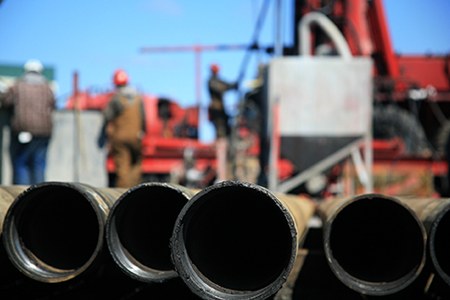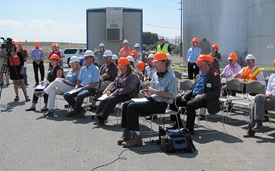Preliminary Findings and Future Directions
 Initial results from monitoring systems and modeling efforts indicate the injected CO2 remains within the targeted formation and at a depth between 2,720 feet and 2,785 feet. Temperature and pressure levels within the reservoir have returned to pre-injection conditions. These results corroborate with pre-injection computer simulations. Sampling activities and monitoring of the well site will continue for 14 to 18 months following injection, and will likely conclude in late 2015 or early 2016.
Initial results from monitoring systems and modeling efforts indicate the injected CO2 remains within the targeted formation and at a depth between 2,720 feet and 2,785 feet. Temperature and pressure levels within the reservoir have returned to pre-injection conditions. These results corroborate with pre-injection computer simulations. Sampling activities and monitoring of the well site will continue for 14 to 18 months following injection, and will likely conclude in late 2015 or early 2016.
As one of the world’s first carbon storage projects into basalt formations, the Wallula Basalt pilot test is providing crucial knowledge regarding the long-term potential to safely and securely store CO2 within deep underground basalt environments. The project has achieved several notable accomplishments:
- The project completed successful injection of nearly 1,000 tons of CO2 into the Grande Ronde basalt formation. Injection was followed by extensive monitoring in order to assess how the injected CO2 responded, moved, and behaved within the surrounding basalt setting.
- The results from the Basalt pilot seismic survey represent the first known success of surface-based imaging of basalt geology as well as the first detailed reconnaissance-level characterization of the Columbia River Basalt Province within the state of Washington.
- By conducting a robust assessment of surface and subsurface environmental characteristics, the project has established a valid baseline measurement and is thus equipped to monitor the CO2 over time and with changing environmental conditions.
Microbiological Monitoring
To understand the in-situ microbial dynamics in response to CO2 injections, a piggyback activity with the geochemical monitoring activities will allow for evaluation of the impact on the in situ microbial community in the injection reservoir. Sampling of the pre- and post-injection reservoir fluids, in conjunction with planned geochemical sampling via Westbay systems downhole tool will enable determination of the rate of return of the reservoir to pre-injection conditions. It will also enable a crucial test of theoretical predictions, including any potential unanticipated microbiological dynamics such as the microbial conversion of CO2 to methane gas.
Public Outreach and Education
 Working closely with their Wallula partners, including Battelle, Boise Inc., Energy Solutions, PraxAir, Schlumberger, Shell, Portland General Electric, and the Washington Department of Ecology, BSCSP will continue to actively engage with the public and provide the most recent and accurate details on project outcomes and future activities related to the basalt carbon storage project. Ongoing outreach objectives include:
Working closely with their Wallula partners, including Battelle, Boise Inc., Energy Solutions, PraxAir, Schlumberger, Shell, Portland General Electric, and the Washington Department of Ecology, BSCSP will continue to actively engage with the public and provide the most recent and accurate details on project outcomes and future activities related to the basalt carbon storage project. Ongoing outreach objectives include:
- Provide up-to-date information on the project’s progress,
- Identify people and organizations in the community with vested interests in the area and proactively approach them to elicit key concerns and questions about the project,
- Work extensively with various stakeholders to resolve issues and conflicting goals, and
- Participate with a broader network of people, organizations, and other groups in the region in order to establish a framework to understand the larger implications of carbon capture and storage technologies and climate change.
